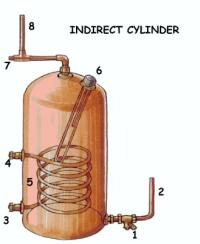Warning: To complete electrical works you must comply with Electrical Regulations – Click here for more information.
Replacing an immersion heater may be a plumbers job or it may be an electricians job. The building trade have never been sure! One thing is for sure though, if you immersion goes or rather the elements on your immersion heater go, the chances are that the whole house will be in darkness as the circuits cut out. Immersion heaters are in the water all the time, expanding and contracting with the heat and everynow and again the protective covering will give way allowing a little water in. Water and electricity do not mix and a short circuit quickly follows. As soon as the lights go out it is natural to call for an electrician. Then the electrician comes, traces the fault and says "Its a plumbers job!".
Sometimes your water just takes forever to heat up and it could be time to replace your immersion heater because it is scaled up.

Cross section of hot water tank with immersion heater
Most electricians know how to replace an immersion heater but its not that hard and this project will show you how to do it yourself. Number 6 in the image left is the immersion heater in the hot water tank. Do not worry about the other numbers, you can find out what they mean in our project on domestic hot water systems
As with anything else to do with electrics, turn all the power off first and remove the fuse in the double pole switch connecting the immersion heater to the mains.
If the hot water in your home suddenly gets scalding hot then it is likely to be a faulty thermostat in your immersion heater and this is dealt with in another project. Wiring an immersion heater.
As the hot water in a hot water system rises to the top of the cylinder, even with a top entry immersion heater as shown, you should drain down the tank. You must first turn off any boiler that is supplying hot water to the tank then stop any more cold water entering the tank. The cold water enters the tank at the bottom and rises as it is heated, to be drawn off as hot water, from the top of the tank.
If you can find the gate vale that stops cold water entering the tank its great. If not you may need to turn off the water at the mains. Once cold water had stopped going into the tank you need to drain the tank down using the drain plug at the bottom by the cold inlet. Fix a hose pipe to the drain plug and run it into the downstairs sink or toilet. Turn on the downstairs hot taps to speed up the process.
Once the tank is empty, use the wiring an immersion heater project to disconnect all of the wiring from the immersion heater.
When all the wires are out of the way, squirt some WD40 between the tank and the nut. Leave this for as long as possible, repeating the squirt once or twice over the next few minutes. Then apply the immersion spanner (preferably the box spanner type shown in the image as it will not slip off) and turn to the left. You may need to work hard to undo this nut as they very often get stuck firm.

Immersion heater spanner
Heater elements come in 7, 11, 18 and 27 inch lengths and you may well have two in your tank. Measure the one you take out and replace it with the same length fitting. Wrap some PTFE tape around the thread of the new fitting and tighten securely. Close all the taps you opened earlier, tighten any drain plugs and refill the system with water. Wire up the thermostat and set it to the temperature you want. Replace the cover and all is well.
Please ensure all electrical connections are made tight. Loose connections can cause fires.

